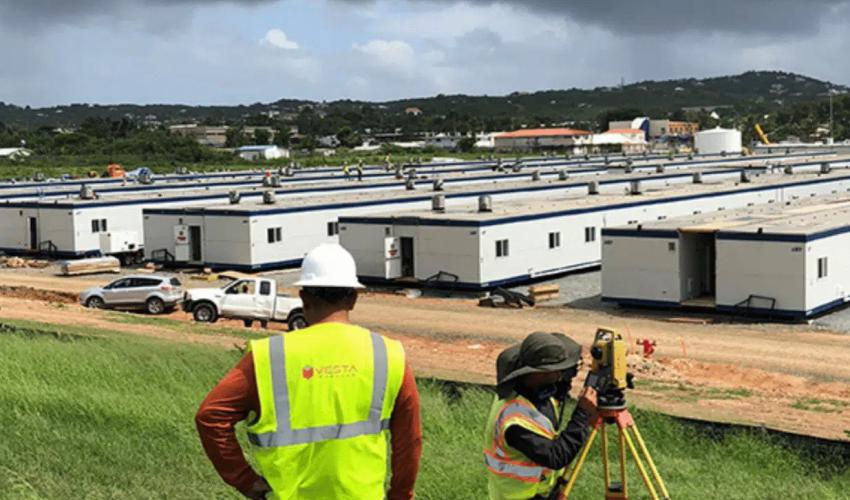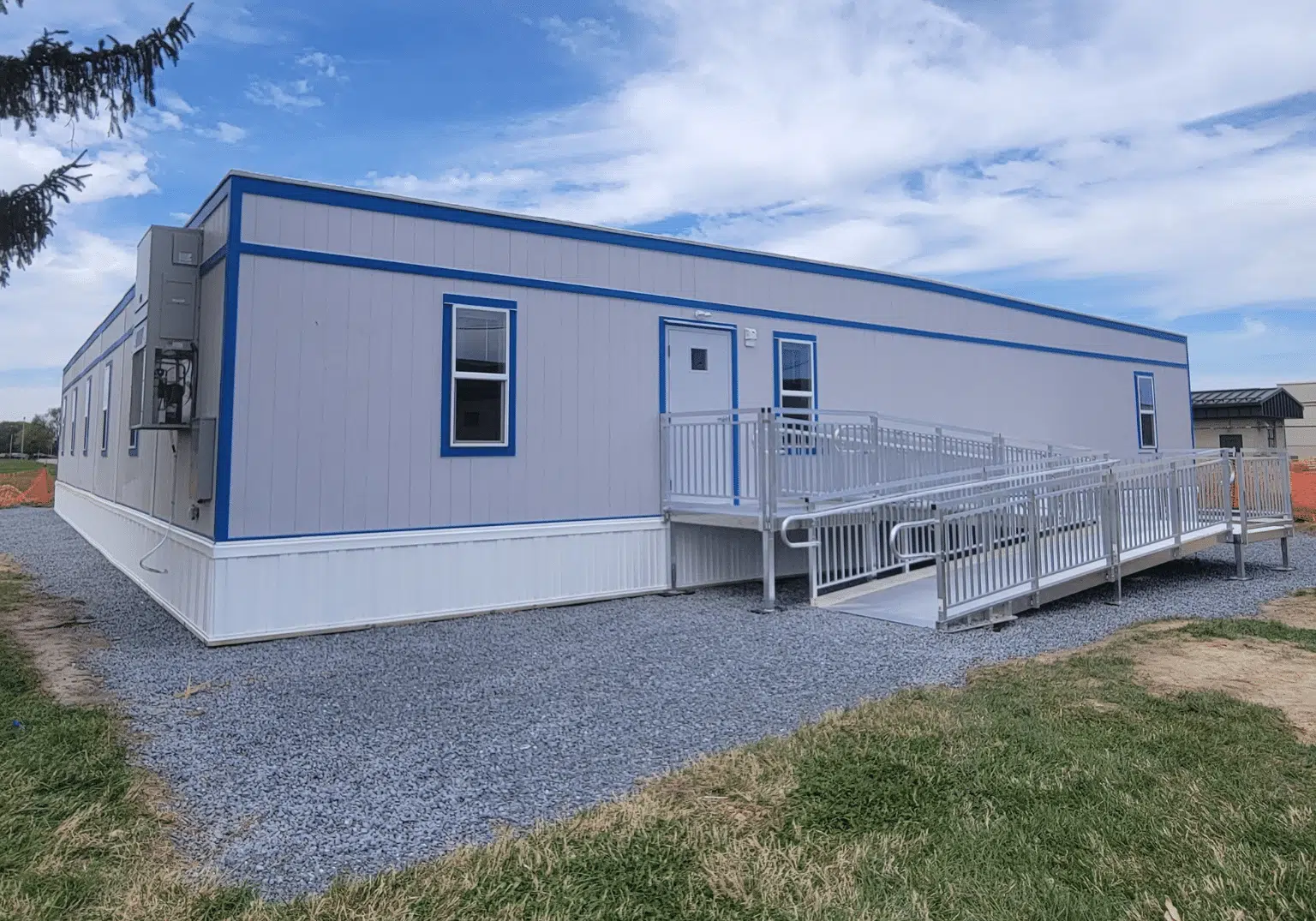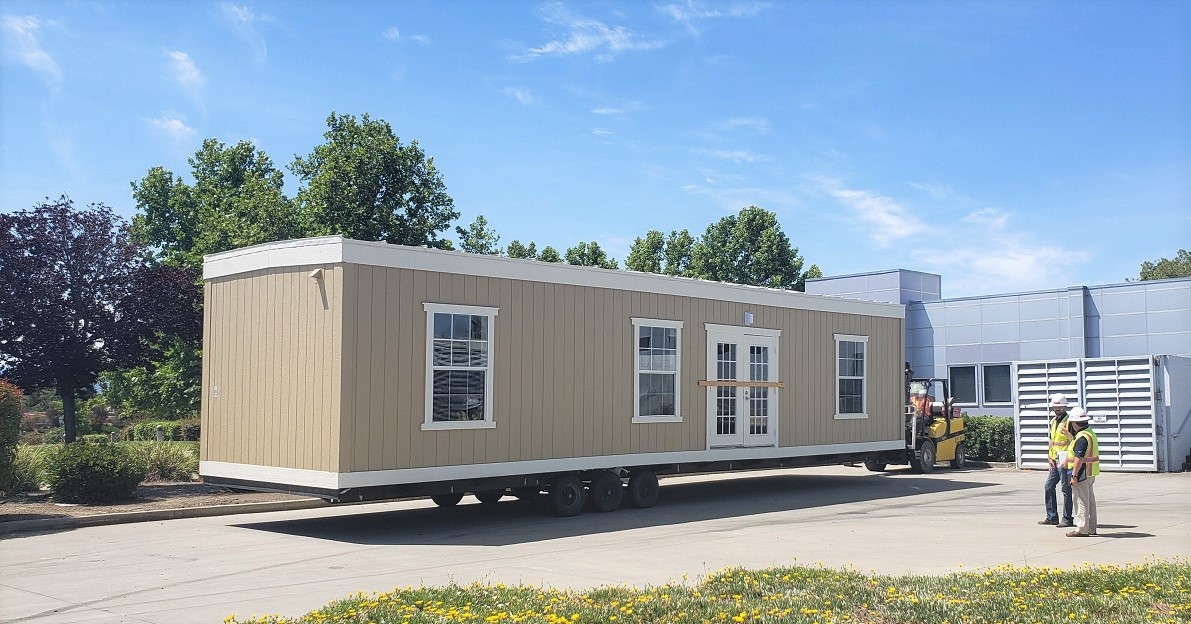Securing a Swing Space: 7 Advantages of Using Temporary Modular Buildings
Offices move. Companies expand. Landlords renovate. Disasters strike. In other words, stuff happens, and when it does, many organizations find themselves in dire need of a temporary worksite building. To get business done, they need a place to do business.
If you’ve been in business for long enough, you might have heard the term “swing space” being thrown around. People apply a fairly broad definition to this term, and it certainly applies here. A swing space is simply a temporary place to work.
What exactly a swing space looks like can vary widely, though. But relocatable modular buildings provide one popular swing space option that is affordable, easy to move, environmentally friendly, sturdy and highly customizable.
Portable modular buildings can solve your workspace problems faster than almost any other potential solution. In this post, we examine swing spaces, when they are used and why temporary modular buildings are the perfect swing space solution. To learn more, keep reading. To get started on your modular swing space today, reach out to the expert team at MOBILE MODULAR.
What is a Swing Space?
The concept of a swing space is a simple one: it’s a place to work while your office or building is being constructed, renovated, repaired or even fumigated. However, the idea can get more complicated where most ideas tend to find their complexity — in the details.
Swing spaces can be on- or off-site. They can be entire separate buildings or trailers (or modular units!). They can come fully furnished and outfitted or more bare-bones for the DIY operations among us. And finally, they can be easy on the eyes or leave your eyes sore.
What your swing space will ultimately look like will depend on what you have time to plan for, the relocatable temporary buildings provider you choose and your company’s preferences.
5 Common Uses for Swing Spaces
The primary purpose of any swing space is to provide a temporary place to work. But the reasons why companies might need swing spaces can vary somewhat widely. We explore a few of those reasons below.
1. Temporary Buildings During Construction or Renovation
Sometimes, the people who make up a company are ready to get to work before the company’s office building is ready to house them. When wasted time is wasted revenue, the idea of having everyone wait around at home while the construction crew finishes the building simply isn’t acceptable.
In so many cases, the solution to such a problem is a swing space. Whether it’s in the parking lot of the future office building or on a completely different property, a swing space gives eager teams a place to get their work done comfortably and efficiently. And for new companies, having a place to work at the outset can help get the operation off the ground at a critical time.
Swing spaces serve a similar purpose for companies whose permanent workspaces are getting a facelift. During renovations, your employees don’t want to have to sidestep construction crews and squeeze down hallways crowded with lumber and paint. They need a quiet, professional place to work.
Considering the fact that commercial renovations can take anywhere from a couple of months to over a year, depending on the size of the office and the scope of the renovations, a transition space is likely to prove to be essential for most companies and commercial building owners who want to make some changes.
2. Swing Spaces as Disaster Response
Tornado damage, hurricane damage, fire damage and flood damage are no longer just fears that live somewhere in the back of your mind and never come to pass. Damage from natural disasters is common. And because of a wide variety of factors, including climate change, these disasters are becoming more common.
When wildfires burn entire neighborhoods in the Western United States, hurricanes strike the East Coast and floods wash away entire city blocks in low-lying coastal areas, people and businesses are displaced. In just the same way people need a place to live when natural disasters strike, companies need a place to operate if they want to continue doing business.
Disaster response can take months — sometimes years. Most companies don’t have the kind of cash reserves it would take to cease operations for that long, and their employees certainly don’t want to miss their income for that long. Once the smoke has cleared, the rain has stopped or the flood waters have subsided, setting up a swing space may be the only way to get back in business in a timely manner.
3. Temporary Space During a Company Move
Whether a company is moving to save on commercial lease costs, house more employees or operate in a more strategic location, the move is going to be disruptive to the day-to-day operations employees are accustomed to. That’s almost always going to result in a loss of productivity and revenue.
A transition space offers a way to mitigate the damage. Instead of letting two commercial leases overlap for months to get the new space work-ready or keeping everyone at home for a week or more while the move happens, companies can set up a swing space to allow their employees to keep working while the move is going on.
4. Temporary Portable Buildings to Handle Overflow
In some cases, companies may find that they have occasional influxes of employees at one location or another. This might be due to major new deals or clients coming in or seasonal ramping up of work, such as tax season for CPA firms.
These are times when companies might opt for swing spaces that can be relocated. Temporary modular buildings and trailers work well for that purpose. With temporary portable buildings, companies can position swing spaces strategically to handle overflow at multiple locations throughout the year.
5. Portable Temporary Housing
Modular buildings make for great temporary housing in a wide variety of situations. For example, if you need to house your employees at a remote worksite, there’s no need to invest in a stick-built structure or relegate them to low-quality trailers. Modular buildings can have all the amenities necessary for remote work housing without all of the hassles.
Another great example of using modular buildings as portable temporary housing can be found in group-living situations, such as dormitories and residential facilities. These types of residences must sometimes undergo renovations, and sometimes they are hit hard by natural disasters. In either case, a nearby modular structure can house the residents while the repair or renovation work is done.
Types of Temporary Structures
Swing spaces can literally save the work day. But what exactly do these spaces look like? You can call a lot of types of temporary structures “swing spaces.” We examine a few of the most popular swing space structures below.
Temporary Modular Buildings
Portable modular buildings are structures made up of one or more “modules,” which are simply closed and fully operational building units. These units are constructed in factory settings and delivered to their destination, where they are laid on a foundation, installed and hooked into utilities.
Modular buildings can be permanent or temporary. In the case of relocatable modular buildings as swing spaces, they are temporary. That means they are meant to be disassembled and moved elsewhere once the need for the swing space has resolved.
Trailers
A popular option for schools and medical facilities, trailers can be towed to sites quickly and can come furnished and fully outfitted with utilities and furniture. As swing spaces, trailers can be a quick and relatively turnkey option.
Shipping Containers
Shipping containers can retire from life at sea and become swing spaces. Some companies, such as MOBILE MODULAR can even turn them into beautiful, stackable and connectable temporary modular buildings.
Swing Space Rentals
While a rented workspace isn’t exactly a type of temporary structure, it needs to be mentioned on this list because many companies do offer temporary office space to companies that are in transition or awaiting building repairs.
While a ready-made swing space option that is likely to come with a snack bar might be an attractive option, rented swing spaces are often prohibitively expensive. These businesses also sometimes ask for fixed, long-term contracts that may not work well for relatively fluid construction or renovation timelines.
7 Major Benefits of Temporary Modular Buildings
At MOBILE MODULAR we specialize in modular buildings. Our world-class engineering and construction experts could handle almost any kind of building project, but we choose modular buildings because we believe they offer a unique solution to countless construction, architectural, design, portable temporary housing and workplace problems, including the problem of needing temporary worksite buildings.
Temporary or permanent modular buildings, portable or fixed — you have to appreciate the flexibility that a modular building provides your company, school or business when you need a swing space.
But what makes relocatable temporary buildings so attractive to a number of U.S. and global industries in need of temporary worksite buildings and other swing spaces?
Below, we explore seven benefits that we think everyone can enjoy the next time they need a temporary space solution, whether it’s a swing space or something else entirely.
1. On-demand Deployment and Installation
A number of modular building companies, such as MOBILE MODULAR, have a fleet of temporary buildings that are kept in supply yards all across the United States. They’re already assembled, located near you and can be delivered within weeks (sometimes less!).
So should an emergency arrive, unexpected construction be necessary or you simply waited too close to the deadline to place an order, you can contact a modular building company to help meet your timeline goals.
2. Easily Add More Buildings on Your Property
There is no limit on the number of temporary modular buildings you can add as long as space on your site or campus allows you to.
Perhaps you ordered one temporary classroom building to accommodate an influx of new students from a nearby district. You find out that another nearby district is also downsizing and you’ll need space for another influx of students.
Temporary buildings allow you to conveniently add another building or combine modules to make larger relocatable building systems.
3. Relocatable Buildings
Plans change and construction projects evolve regularly. If you have a temporary building on your site, it can always be relocated to conveniently accommodate your needs. Relocatable buildings provide the ultimate degree of flexibility.
4. Leasing and Co-op Purchase Options
Another major benefit of temporary buildings is the ability to lease or participate in various co-op purchase options (governments and school organizations).
If you know you’ll only require your structure for a few years, you might be wise to lease rather than purchase. Always consult a modular building company expert about the financial options on buildings to learn what the best plan is for you.
5. Versatility and Customization for Temporary Buildings
A question we receive quite often is, “Do they look like trailers, or can they look like ‘regular’ buildings?”
We have to emphasize the fact that temporary buildings do not need to look ugly or remain in a traditional, block trailer appearance.
Floor plans, wall layouts, and materials are all customizable. Choose the shape of your building, type of siding, roof design and any other element you would like enhanced.
6. Relocatable Temporary Buildings Have Relatively Long Lifespans
Temporary modular buildings will last longer than you might expect. With regular maintenance and upkeep, the buildings themselves will last for the foreseeable future.
And, while they are often made of lighter materials that make it easier to lift and transport them, that does not mean that they are less reliable or built to subpar standards.
Temporary modular buildings must comply with all the local and state buildings codes and permitting requirements.
7. Temporary Building Options for Disaster Relief and Emergency Services
One of the reasons that temporary buildings work so well during natural disasters and emergency relief efforts is that they are already assembled and available. When a hurricane, tornado, flooding or wild fire strikes, timing of building deployment is a crucial component.
In addition to time, the ability to transport these relocatable building systems to remote locations is crucial. If you’re supplying temporary dormitories or critical swing spaces to emergency services personnel, the ideal construction site location for your space may require the navigation of rural waterways and mountains.
Temporary modular buildings make all of this possible as they are transportable by almost every mode of transportation — semi-truck and trailer, rail, ship and crane.
Understanding the Types of Temporary Modular Buildings
“Temporary buildings” is a very broad phrase that covers a significant number of building types and uses. You’ll often hear them referred to as portable buildings, mobile buildings, trailers, and containers.
However, the relocatable modular buildings industry utilizes offsite construction practices, in which buildings or buildings modules are assembled in factory environments.
All of the modules begin as transportable pieces of a larger, more complex construction project. That’s why temporary buildings don’t only include single-wide commercial trailers.
Your temporary buildings might be a multi-story dormitory or man camp that is 10,000+ square feet large. And you may be using it for five to 10 years (or more!).
On-demand, Singular Mobile Buildings and Building Trailers
There are prefabricated portable modular buildings that are sometimes referred to as mobile buildings, or building trailers. They are frequently used as temporary mobile offices, classroom trailers and storage containers.
Complex Modular Portable Buildings
Larger, multi-module and multi-story temporary building complexes are also available. These help to give a significant number of staff and clients a space to work or rest in, and are available for longer term periods.
These are made possible by utilizing custom-built modules or by arranging pre-built modules from our inventory and assembling them together.
Mobile Modular Modular Swing Space Projects
At MOBILE MODULAR, we have completed countless relocatable building systems to suit a nearly endless variety of construction needs, including swing spaces of all kinds. Below, we examine a few temporary modular swing space projects we have delivered.
Camp Lejeune
When Hurricane Florence struck in 2018, it caused 53 deaths and billions of dollars in damage across multiple continents, including the Carolinas on the East Coast of the United States. The Category 4 storm struck and damaged Camp Lejeune, a Marine Corps base in Jacksonville, North Carolina. And MOBILE MODULAR provided a swing space solution while the base was being repaired.
In total, MOBILE MODULAR provided seven unique swing space buildings for a total of more than 14,000 square feet. One of the relocatable buildings was a high-security government building. We were able to deliver the entire turnkey project in under 60 days.
Karmanos Cancer Institute
In Farmington Hills, Michigan, the Karmanos Cancer Institute was undergoing major construction on its existing facility and needed swing space to prevent any disruptions to patient care.
The institute selected MOBILE MODULAR as the temporary modular building provider for the project. In total, we delivered 5,600 square feet of swing space under tight timelines and budgetary requirements.
University of Richmond
In the face of the COVID-19 pandemic, academic institutions were left scrambling for student housing and isolation solutions that could stand up to the new global threats everyone had to face. The University of Richmond chose temporary modular buildings as the solution to their need for a transition space that could temporarily house students who had to be isolated from others.
In 60 days, MOBILE MODULAR built, delivered and installed 150 bedrooms’ worth of portable temporary housing that included all the amenities of dorm rooms and all the safety precautions of world-class medical facilities.
Relocatable Modular Building FAQs
For many businesses, the concept of temporary modular swing spaces is a new one, and that means they have a lot of questions. We’re here to answer those questions. Here are some of the most common questions about relocatable building systems and their answers.
Are Relocatable Buildings Up to Code?
Yes. If you use a reputable modular building provider, your modular units will be completely up to building codes. Your provider will work with you to understand local building code and permitting concerns to make sure you have nothing to worry about after your units are installed.
Are Portable Modular Buildings Secure and Safe?
Modular buildings are often used in some of the harshest environments on the planet, from the Arctic Circle to deep in the rainforest. They can stand up to the elements, and they’re designed to be just as secure as any building with a locking door. On top of that, modular buildings are commonly used in high-security environments, such as government contracting.
Do I Have to Transport Relocatable Temporary Buildings Myself?
In most cases, modular building providers like MOBILE MODULAR Modular will deliver and install the units, regardless of whether you are renting or purchasing them. If you would like to relocate the buildings yourself after initial installation, you can, but many modular building providers will do that for you, too.
Secure Your Swing Space With Temporary Modular Buildings
Want to learn more about swing spaces and temporary modular buildings? Check out this guide about Modular Construction or call our team at 800-819-1084 today. You can also get started by selecting “get a quote” to find out how MOBILE MODULAR can solve your temporary space needs.





